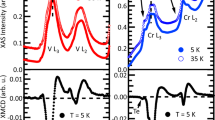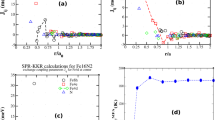Abstract
Dilute magnetic semiconductors are without doubt among the most interesting classes of magnetic materials. However, the nature of their electronic structure and magnetic exchange is far from understood, and important discrepancies exist between widely used phenomenological models and first-principles electronic-structure descriptions. Here we apply the ab initio self-interaction-corrected local-spin-density method to study the electronic structure of Mn-doped III–V semiconductors. For (GaMn)As, our results with the (d5+h) configuration agree with the Zener model description and predict p–d exchange that is in good agreement with experiment. The ground state in (GaMn)N and (GaMn)P is the d4 configuration with no intrinsic carriers. If, however, holes are introduced extrinsically, carrier-mediated exchange is possible, but the p–d exchange is predicted to be lower in p-type GaN, as compared with GaP and GaAs. Nevertheless, because of the smaller lattice constant, the estimated Curie temperature is higher than in (GaMn)As, at comparable doping levels.
This is a preview of subscription content, access via your institution
Access options
Subscribe to this journal
Receive 12 print issues and online access
$259.00 per year
only $21.58 per issue
Buy this article
- Purchase on Springer Link
- Instant access to full article PDF
Prices may be subject to local taxes which are calculated during checkout





Similar content being viewed by others
References
Foxon, C. T. et al. The growth of high quality GaMnAs films by MBE. J. Mater. Sci.: Mater. El. 15, 727–731 (2004).
Wolf, S. A. et al. Spintronics: A spin-based electronics vision for the future. Science 294, 1488–1495 (2001).
Ohno, H. et al. Electric field controle of ferromagnetism. Nature 408, 944–946 (2000).
Berger, L. Emission of spin waves by a magnetic multilayer traversed by a current. Phys. Rev. B 54, 9353–9358 (1996).
Slonczewski, J. C. Current-driven excitation of magnetic multilayers. J. Magn. Magn. Mater. 159, L1–L7 (1996).
Dietl, T., Ohno, H., Matsukura, F., Cibert, J. & Ferrand, D. Zener model description of ferromagnetism in zinc-blende magnetic semiconductors. Science 287, 1019–1022 (2000).
Zener, C. Interaction between the d shells in the transition metals. Phys. Rev. 81, 440–444 (1950).
Zener, C. Interaction between the d-shells in transition metals. III. Calculations of the Weiss factor in Fe, Co, and Ni. Phys. Rev. 83, 299–301 (1951).
Sonoda, S., Shimizu, S., Sasaki, T., Yamamoto, Y. & Hori, H. Molecular beam epitaxy of wurtzite (Ga,Mn)N films on sapphire (0001) showing the ferromagnetic behavior at room temperature. J. Cryst. Growth 237–239, 1358–1362 (2002).
Schneider, J., Kaufmann, U., Wilkening, W., Baeumler, M. & Köhl, F. Electronic structure of the neutral Manganese acceptor in gallium arsenide. Phys. Rev. Lett. 59, 240–243 (1987).
Kreissl, J. et al. Neutral manganese acceptor in GaP: An electron-paramagnetic-resonance study. Phys. Rev. B 54, 10508–10515 (1996).
Dietl, T., Ohno, H. & Matsukura, F. Hole-mediated ferromagnetism in tetrahedrally coordinated semiconductors. Phys. Rev. B 63, 195205 (2001).
Lee, B., Jungwirth, T. & MacDonald, A. H. Ferromagnetism in dilute magnetic semiconductor heterojunction systems. Semicond. Sci. Technol. 17, 393–403 (2002).
Alvarez, G., Mayr, M. & Dagotto, E. Phase diagram of a model for dilute magnetic semiconductors beyond mean-field approximations. Phys. Rev. Lett. 89, 277202 (2002).
Chattopadhyay, A., Sarma, S. D. & Millis, A. J. Transition temperature of ferromagnetic semiconductors: A dynamical mean field study. Phys. Rev. Lett. 87, 227202 (2001).
von Barth, U. & Hedin, L. A local exchange-correlation potential for the spin polarized case: I. J. Phys. C 5, 1629–1642 (1972).
Hohenberg, P. & Kohn, W. Inhomogeneous electron gas. Phys. Rev. B 136, 864–871 (1964).
Kohn, W. & Sham, L. Self-consistent equations including exchange and correlation effects. Phys. Rev. A 140, 1133–1138 (1965).
Martin, R. M. Electronic Structure: Basic Theory and Practical Methods (Cambridge Univ. Press, Cambridge, 2004).
Kübler, J. Theory of Itinerant Electron Magnetism (International Series of Monographs on Physics, Vol. 106, Oxford Univ. Press, Oxford, 2000).
Sato, K. & Katayama-Yoshida, H. First principles materials design for semiconductor spintronics. Semicond. Sci. Technol. 17, 367–376 (2002).
Mahadevan, P. & Zunger, A. Ferromagnetism in Mn-doped GaAs due to substitutional-interstitial complexes. Phys. Rev. B 69, 115211 (2004).
Temmerman, W. M., Svane, A., Szotek, Z. & Winter, H. in Electronic Density Functional Theory: Recent Progress and New Directions (eds Dobson, J. F., Vignale, G. & Das, M. P.) 327 (Plenum, New York, 1998).
Perdew, J. P. & Zunger, A. Self-interaction correction to density-functional approximations for many-electron systems. Phys. Rev. B 23, 5048–5079 (1981).
Norman, M. R. & Koelling, D. D. Towards a Kohn-Sham potential via the optimzied effective-potential method. Phys. Rev. B 30, 5530–5540 (1984).
Strange, P., Svane, A., Temmerman, W. M., Szotek, Z. & Winter, H. Understanding the valency of rearearths from first-principles theory. Nature 399, 756–758 (1999).
Petit, L., Svane, A., Szotek, Z. & Temmerman, W. M. First-principles caulculations of PuO2±x . Science 301, 498–501 (2003).
Temmerman, W. M., Winter, H., Szotek, Z. & Svane, A. Cu valency change induced by O doping in YBCO. Phys. Rev. Lett. 86, 2435–2438 (2001).
Svane, A. & Gunnarsson, O. Transition-metal oxides in the self-interaction-corrected density-functional formalism. Phys. Rev. Lett. 65, 1148–1151 (1990).
Szotek, Z., Temmerman, W. M. & Winter, H. Application of the self-interaction correction to transition-metal oxides. Phys. Rev. B 47, 4029–4032 (1993).
Ködderitzsch, D. et al. Exchange interactions in NiO and at the NiO(100) surface. Phys. Rev. B 66, 064434 (2002).
Edmonds, K. W. et al. Mn interstitial diffusion in (Ga,Mn)As. Phys. Rev. Lett. 92, 037201 (2004).
Edmonds, K. W. et al. Ferromagnetic moment and antiferromagnetic coupling in (Ga,Mn)As thin films. Phys. Rev. B 71, 064418 (2005).
Sawatzky, G. A. & Allen, J. W. Magnitude and origine of the band gap in NiO. Phys. Rev. Lett. 53, 2339–2342 (1984).
Zaanen, J., Sawatzky, G. A. & Allen, J. W. Band gaps and electronic structure of transition-metal compounds. Phys. Rev. Lett. 55, 418–421 (1985).
van Elp, J., Potze, R. H., Eskes, H., Berger, R. & Sawatzky, G. A. Electronic structure of MnO. Phys. Rev. B 44, 1530–1537 (1991).
Mahadevan, P. & Zunger, A. Trends in ferromagnetism, hole localization, and acceptor level depth for Mn substitution in GaN, GaP, GaAs, and GaSb. Appl. Phys. Lett. 85, 2860–2862 (2004).
Ashcroft, N. W. & Mermin, N. D. Solid State Physics (Thomson Learning, Stamford, 1976).
Okabayashi, J. et al. Core-level photoemission study of Ga1−xMnxAs . Phys. Rev. B 58, R4211–R4214 (1998).
Fischer, S., Wetzel, C., Haller, E. E. & Meyer, B. K. On p-type doping in GaN-acceptor binding energies. Appl. Phys. Lett. 67, 1298–1300 (1995).
Kohler, U., Lubbers, M., Mimkes, J. & As, D. J. Properties of carbon as an acceptor in cubic GaN. Physica B 308, 126–129 (2001).
Temmerman, W. M., Szotek, Z. & Winter, H. Band-structure method for 4f electons in elemenetal Pr metal. Phys. Rev. B 47, 1184–1189 (1993).
Okabayashi, J. et al. Mn 3d partial density of states in Ga1−xMnxAs studied by resonant phototemission spectroscopy. Phys. Rev. B 59, R2486–R2489 (1999).
Acknowledgements
This research used resources of the Center for Computational Sciences at Oak Ridge National Laboratory. It was supported by the Defense Advanced Research Project Agency as well as by the Division of Materials Science and Engineering of the Office of Basic Energy Sciences, US Department of Energy. Oak Ridge National Laboratory is managed by UT-Batelle, LLC, for the US Department of Energy under Contract No. DE-AC05-00OR22725.
Author information
Authors and Affiliations
Corresponding author
Ethics declarations
Competing interests
The authors declare no competing financial interests.
Rights and permissions
About this article
Cite this article
Schulthess, T., Temmerman, W., Szotek, Z. et al. Electronic structure and exchange coupling of Mn impurities in III–V semiconductors. Nature Mater 4, 838–844 (2005). https://doi.org/10.1038/nmat1509
Received:
Accepted:
Published:
Issue Date:
DOI: https://doi.org/10.1038/nmat1509
This article is cited by
-
On the doping of the Ga12As12 cluster with groups p and d atomic impurities
Theoretical Chemistry Accounts (2021)
-
Towards intermediate-band photovoltaic absorbers: theoretical insights on the incorporation of Ti and Nb in In2S3
npj Computational Materials (2020)
-
Non-local effect of impurity states on the exchange coupling mechanism in magnetic topological insulators
npj Quantum Materials (2020)
-
Electronic and Magnetic Investigations of Rare-Earth Tm-doped AlGaN Ternary Alloy
Journal of Superconductivity and Novel Magnetism (2018)
-
A ten-year perspective on dilute magnetic semiconductors and oxides
Nature Materials (2010)



